It is no secret that the video gaming industry
has a love affair with technology. Back when the first 3D games came out, video
games were just all about movement. Flight sims—particularly those with six
degrees of freedom games like the Descent series—flourished. Sure, there were
games that broke the mold (one of which is the forebear to the Avernum
series) but most of these only got a cult following and largely took the
backseat. In 1998, Valve’s seminal game, Half-Life, happened. Suddenly, flight
sims vanished and the industry jumped into the first-person shooter bandwagon.
Fast forward to the second half of the first decade of the 2000s and on-rails
shooter focusing on powerful action sequences elevated the FPS industry to new
heights. And QTEs. Lots of QTEs.
It was this predictable sine wave of trends
that killed my fascination for triple A productions. Companies started getting
into projects that were considered to be financially safe—you cannot imagine
the number of Call of Duty clones that popped into existence like drab-hued
mushrooms after a stormy night. There was no experimentation and aside from the
drive to ramp up visual fidelity, no pushing of the envelope. Things started
feeling to be run-of-the-mill affairs, cookie cutter products that rolled out
the digital assembly lines like virtual minions of doom that conquered the
world.
It was a breath of fresh air then that back in
2009 or so, a friend of mine told me about Spiderweb Software and their Avernum
series. Intrigued, I pored over their site. Sure enough, the isometric view and
the hand drawn sprites intrigued me to no end. For some reason though, I didn’t
buy a single one. Which was just as well as recently, the first game in the
series floated on my radar as a remake. I figured that with the new engine and
revamped graphics it was a good time to jump into what Spiderweb Software was
offering.
I never regretted the decision.
I never regretted the decision.
Avernum: Escape from the Pit is a turn-based, isometric, role-playing game that may not have
impressive visuals but stands up on its own—and then some—on its other aspects.
Avernum:
Escape from the Pit puts you in the role of an exile who gets consigned
into the eponymous underground world of Avernum after having been found guilty
of a crime vaguely phrased as “defying the empire.” After you land in the
stygian gloom, you meet one NPC after another, some friendly, some hostile, and
you soon assemble a 4-man party and embroil yourself in the affairs of the vast
underground world.
“Vast” is,
indeed, the word to describe Avernum. It might be an underground warren where
the Empire stuffs what it deems as its undesirables, but the place is as large
as most RPG worlds. Castles, towns, outposts, mines, mage sanctuaries that
teeter on the edge of lakes of lava, monster lairs, and other domiciles of
various sizes dot the landscape. Most of these hold NPCs that give you quests
and while a good number of these missions are linked ones that form the main
plot, the rest are optional side quests that range from the harrowing to the hilariously
absurd.
Absurd? Yes,
there are quests in the game that let you deal with eccentrics and a community
of zany individuals whose nature I won’t divulge as that particular errand is one
of the gems in the game that I uncovered.
Most of the RPGs that have grabbed my undivided attention are ones that feature open world, non-linear gameplay. The Golden Sun and Zelda series as well as the multitude of Metroidvania games are prime examples. Avernum: Escape from the Pit is no different; it has captured this formula and instilled into it an immersive story that tells the plight of the different fiefdoms that have emerged in this subterranean realm. In the game, you have the freedom to go gallivanting among civilized holdings and outlying territories that not even the hardiest militia patrol. During the course of the game, you will get quests that necessitate that you go to and fro among Avernum’s locales. You will also get to acquaint your party with enterprising NPCs who need specific goods. All these make your expeditions across the lands of Avernum rewarding; you travel to a certain locale, uncover a stash of ale, remember that a certain merchant in a certain town needs great quantities of the stuff, you make for that town, get ambushed by a squad of brigands who then drop bars of iron when you kill them, and then recall that a smithy halfway across the world map needs that metal. There’s never a moment in the game where you feel lost—you will have always a destination in mind and this is just one of the things that make the game addictive.
 |
| This dragon can lay waste to an entire city. Yet it is peaceful, keeps a healthy, more-than-civil relationship with the surrounding cities, and keeps two cats which it adores immensely. |
Most of the RPGs that have grabbed my undivided attention are ones that feature open world, non-linear gameplay. The Golden Sun and Zelda series as well as the multitude of Metroidvania games are prime examples. Avernum: Escape from the Pit is no different; it has captured this formula and instilled into it an immersive story that tells the plight of the different fiefdoms that have emerged in this subterranean realm. In the game, you have the freedom to go gallivanting among civilized holdings and outlying territories that not even the hardiest militia patrol. During the course of the game, you will get quests that necessitate that you go to and fro among Avernum’s locales. You will also get to acquaint your party with enterprising NPCs who need specific goods. All these make your expeditions across the lands of Avernum rewarding; you travel to a certain locale, uncover a stash of ale, remember that a certain merchant in a certain town needs great quantities of the stuff, you make for that town, get ambushed by a squad of brigands who then drop bars of iron when you kill them, and then recall that a smithy halfway across the world map needs that metal. There’s never a moment in the game where you feel lost—you will have always a destination in mind and this is just one of the things that make the game addictive.
If you’re not
fond of long treks, fret not; the game has portals in most of the places you
visit and these interconnect with each other through a hub. From that hub you
can make jumps to any region you want to go to. And aside from these teleports
and entering cities, towns, lairs, and ruins, the world of Avernum is a
seamless experience; if you don’t use the portals or enter a holding, you can
roam across the countryside without seeing a loading screen.
Is the landscape
a sight to see? Well, remember that Avernum
is a remake of a 1995 video game and while the game engine has been
replaced, the aesthetics are more or less the same stuff you saw way back the
mid 90s. That doesn’t mean to say though that it looks bad. Avernum has decent sprites and the
isometric terrain does its job. Spell effects are not too shabby and while
there is no ambient lighting owing to it being an isometric, 2D game, some of
the area of effect spells are actually impressive to behold given the game’s
age. Enemies and NPCs have a great amount of variety but not too much that you
don’t see reused sprites; a good deal of enemies you will see in the late game
use the same sprites you saw in the early parts. (Zombies and ghosts are prime
examples of enemies with recurring visuals.) What disappointed me greatly
though were the summons. I invested points in my spellcasters’ summoning
abilities and imagine my chagrin when the late game summoning spells only
produced recycled sprites. Imagine if I you were able to summon a fiery
archangel bedecked in plate mail; an avenging angel tearing through the ranks
of undead would have been a sight to see. No dice; the game doesn’t let you
have that.
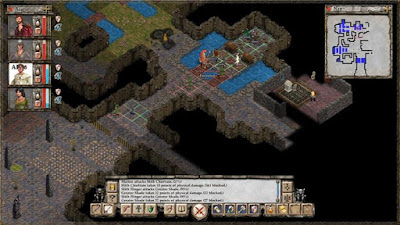 |
| Avernum recycles sprites. Even bosses are just reskins of their minions. Nonetheless, encounters are engrossing affairs. |
Speaking of combat, it’s a turn-based, tiled affair where you and the game’s AI take turns moving characters and dishing out damage. It’s here that Avernum’s foibles become apparent. As a 2D game, you can’t rotate the camera and selecting characters can be a bit of a hassle if a multitude of sprites have converged on a small area. It doesn’t help that sprites in the game are more or less the same 1-square size; there really are instances where it will take you more than two seconds to pick out that dying boss with your cursor from the throng of minions surrounding it. Then too, there’s the problematic tile selection. This is my biggest gripe about the game. It’s a common scenario where I can’t get to choose the tile I want a character to go to because placing my cursor on that tile highlights the nearest monster. Often, in exasperation, I would just eschew tactical advantage and just attack and hope the other party get wiped out first before mine keel over. It’s these little bits that annoy me but overall, Avernum‘s combat is a pretty engrossing experience. In it, you get action points and you can spend these by moving, attacking, casting spells, using items in your inventory like potions, wands, wizard staffs, and food. Watch out though; the game does use a similar “attack of opportunity” mechanic like the one employed by Wizards of the Coast’s Dungeons & Dragons in that crossing tiles adjacent to an enemy consume more action points than the usual “1 tile moved = 1 action point consumed” rule. Attacking or casting spells also eats up a huge chunk of a character’s action points, so much so that it almost always (unless the character is under the influence of a buff like a Haste spell or the overpowered Adrenaline Rush ability) brings the pool down to zero. Attacking also bars you from moving further no matter how much action points are left so deciding when to attack is a crucial factor in battles, particularly if you’re up against a powerful group.
The game’s AI is
not poor but neither is it brilliant, relying instead on sheer numbers. Enemy
healers do heal and mages do consistently throw pesky debuffs like spells that
slow your characters down, stun them, or make them very inaccurate. However, I
really didn’t feel that I was up against a cunning AI like say, the one in Stardock’s
Galactic Civilization series. Enemies
don’t really flank, don’t recognize the prime targets in your group (the wizard
and the cleric if you’re using them), and don’t protect their leaders. There’s
also the power spikes and the troughs you hit during the course of the game
that at times will bore and frustrate you. However, for the most part, these
noticeable difficulty crests and troughs often set me thinking about what I was
lacking and this knowledge spurred me into playing the game more so I can scrounge
up enough experience or gold to get the skill/spell I wanted. This drive to
surmount obstacles by making your party stronger is, needless to say, a very
addictive ever-present mechanic in cRPGs; Spiderweb Software did a great job of fusing this into Avernum.
Speaking of the ups and downs of the game where difficulty is concerned, the first rut I stumbled headlong into was when enemies started using crippling crowd control effects like terrify, stun, and charm. These really threw my party into disarray. There was also a time when my priest didn’t have any serious damage dealing capabilities and swarms were very difficult to take down given that in terms of dishing out punishment, I was virtually down to three members all the time what with the priest only able to heal and bestow buffs. However, later in the game when I managed to learn spells that cancelled mind-altering debuffs as well as giving my spellcasters some serious area of effect damage-dealing spells, only the most difficult boss parties ever stood a chance against my group. It was here that Avernum fared badly. With its failure to put up a challenge in the late game, I felt that the game stretched out way too long and should have ended itself sooner. Still there were two instances where I got my party wiped during the last six or so boss fights so all in all, it wasn’t really that easy a cakewalk. For the most part though I’d say the game has a moderate difficulty; it wasn’t too difficult yet it wasn’t too easy either.
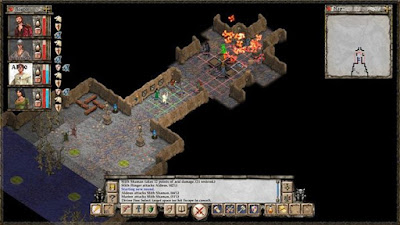 |
| Divine Fire is life. Divine Fire is love. Use it. Embrace it. Cook your enemies with it. |
Speaking of the ups and downs of the game where difficulty is concerned, the first rut I stumbled headlong into was when enemies started using crippling crowd control effects like terrify, stun, and charm. These really threw my party into disarray. There was also a time when my priest didn’t have any serious damage dealing capabilities and swarms were very difficult to take down given that in terms of dishing out punishment, I was virtually down to three members all the time what with the priest only able to heal and bestow buffs. However, later in the game when I managed to learn spells that cancelled mind-altering debuffs as well as giving my spellcasters some serious area of effect damage-dealing spells, only the most difficult boss parties ever stood a chance against my group. It was here that Avernum fared badly. With its failure to put up a challenge in the late game, I felt that the game stretched out way too long and should have ended itself sooner. Still there were two instances where I got my party wiped during the last six or so boss fights so all in all, it wasn’t really that easy a cakewalk. For the most part though I’d say the game has a moderate difficulty; it wasn’t too difficult yet it wasn’t too easy either.
What’s an RPG
without loot? Don’t let the graphics deceive you—though your characters’
sprites may not change when you change their accouterments, Avernum: Escape from the Pit does has a
bewildering array of goodies that you can buy, steal, and loot. From simple spears to
enchanted, legendary armor, you can equip your characters in any way you want
to make them conform to the gameplay style you prefer. Equipment, coupled with your
character’s skills (yes the game has skill trees!), make each character unique.
Do you want a dual-wielding, badass melee fighter? Equip a character with two
one-handed weapons and he/she is all set! Do you want a tank who’s a master of
parrying and striking back at foes? Let him don riposte-boosting equipment and
pour in skill points to his Hardiness, Riposte, Challenger, and Parry skills, and you’ve
got yourself a damage-soaking monolith who will protect your party! Similarly
with spellcasters, there are items that will heighten their mana efficiency and
regeneration, strengthen their blessings and debuffs, and yes, increase the
damage they dish out. There are also consumables you can pick up like mystic stones that increase your experience level and wizard staffs and wands. The latter are a great
boon in the early parts of the game as enemies have low hit points and using them
only consumes minute amounts of action points, enabling you to cast twice in a
turn. However, in the later parts, the damage dealing ones largely fall off as
your enemies—and your spells—do grow more powerful, making them obsolete.
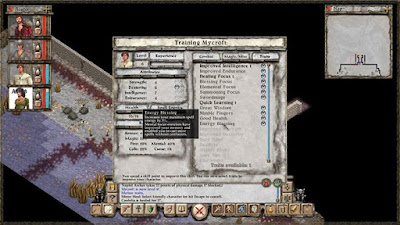 |
| Tailor your party members any way you want. I've made my priest to be as mana efficient as possible---as well as being a deadshot with javelins. |
The game also has several aspects that make it all the more interesting: Aside from the usual loot-sell-and-buy mechanic that almost all RPGs have, there’s a limited crafting system too: NPCs will craft a variety of potions for you if you’ve the components for them. These potions range from ones that replenish mana and hit points to ones that increase your speed, cancel debuffs, and give you limited invincibility. There are also NPCs who can teach you spells or offer training to make one or more of your party members. These trainings encompass a bevy of physical feats including tool use, gymnastics, and of course, becoming more adept at using weapons.
The audio
department is sparse and mundane. There’s nothing really anything I can
complain about it except for the dearth of background music. There’s just the track
when you fire up the main menu but during the game, there’s a pronounced
absence of it; the only background sound you hear in the game are ambient sound
effects. Walk into a cave network and you’ll hear drops of water as of ones
falling from stalactites. Enter a bustling city and you’ll hear the usual din
of hawkers and street urchins playing on the streets. Audio effects in combat
are good but not spectacular. Sheets of lightning crackle, fans of searing
flame boom and hiss, and parried sword strikes sound as they should.
The game is
perfectly replayable but it’s not something I would play again now that I’ve
just recently finished it. My first playthrough lasted nearly 92 hours
according to Steam and while it was definitely a fun romp, I don’t immediately
replay games this long right after I finish them no matter how good they are. In a
year or so I will. And I definitely will given that the game has multiple
endings, lets you ally yourself with whatever faction you want to join, and the ability
to customize your party with whatever members you see fit to add. Next year I’d
probably mix things up and go with spellcasters who can’t summon, a
dual-wielding tank, and maybe an archer. Then I’d make widely deviating choices
from my first playthrough.
After all this
however, the question is, with its dated graphics is Avernum: Escape from the Pit worth its 10-dollar price tag? At more than 90 hours of gaming on my first playthrough across a vast 2D, isometric, nostalgia-inducing landscape filled with interesting locations peppered with lairs, strongholds, and powerful artifacts that only the most intrepid will discover, Avernum: Escape from the Pit is definitely worth its price of admission. Add to this almost peerless writing and it’s easy to see why I’m regarding this game as one of the best in my collection.
Ratings:
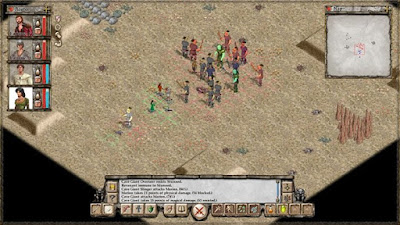 |
| Bad boys! Watcha gonna do when the giants come for you? |
Ratings:
Tilt: 8.5 – Given that I’ve
spent almost 92 hours in this game and
finished it, I can say Avernum: Escape
from the Pit is something else. I’ve spent several sleepless nights over
this one, only quitting when I realized the sun was starting to rise. Spiderweb
Software has some topnotch writers.
Gameplay: 8.0 – If you’re
talking about pure gameplay alone, Avernum
suffers from some design choices like making you too powerful near the end of
the game and other foibles like recycled sprites and unclickable tiles. Still
it does provide a fun romp that even shines head and shoulders from some games
that have triple A funding.
Graphics: 6.0 – It’s here
that Avernum really suffers. With
only a 2D isometric engine, the game really can’t hope to match more recent
RPGs like say, The Age of Decadence.
Its art style, while very good, is nothing to write home about either; it just
doesn’t have anything to make it stand out from the multitude of RPGs out
there in the visuals department.
Audio: 7.5 – Adequate but
again, there’s nothing that makes it stand out. If only they made background
music as impressive as the one used when the main menu fires up though…
Replayability: 8.5 – This
is a pretty divisive point. On one, retro gamers will love replaying this game
that lets you relive the good old days of the 90s. On the other side of the
coin, younger gamers may be put off by its visuals and despite its multiple
endings, may consider this game a one-shot affair. There’s also the matter of
its length: gamers who love protracted adventures blasting hordes of undead and
fantastical creatures will find this game up their alley while ones who are
easily distracted by new releases might find this one to be a stubborn guest that
overstays its welcome. I’m somewhere in the middle but I’m definitely going to
unravel its other endings so I’m giving this an 8.5 replayability rating.
Overall score: 7.7

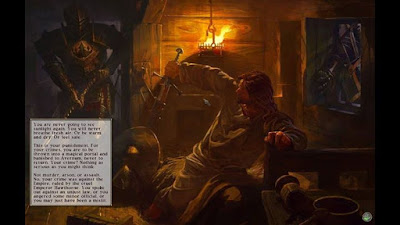




0 comments:
Post a Comment